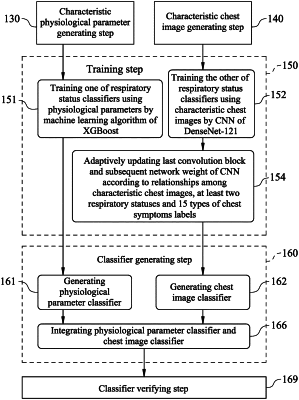| CPC G06T 7/0012 (2013.01) [G06T 7/11 (2017.01); G06T 7/174 (2017.01); G06V 10/764 (2022.01); G06T 2207/10116 (2013.01); G06T 2207/20081 (2013.01); G06T 2207/30048 (2013.01); G06T 2207/30061 (2013.01); G06V 2201/031 (2022.01)] | 10 Claims |

|
1. A respiratory status classifying method, being for classifying as one of at least two respiratory statuses, and comprising:
an original physiological parameter inputting step comprising inputting a plurality of original physiological parameters, which are a plurality of physiological parameters for training, wherein each of the original physiological parameters corresponds to a corresponding one of the respiratory statuses, the original physiological parameters comprise at least one clinical parameter, at least one ventilator parameter and at least one laboratory parameter, each of the clinical parameter, the ventilator parameter and the laboratory parameter is an average value in a time period, which is between 12 hours and 72 hours, and the time period of each of the clinical parameter and the ventilator parameter is smaller than the time period of the laboratory parameter;
an original chest image inputting step comprising inputting a plurality of original chest images, which are a plurality of chest images for training, wherein each of the original chest images corresponds to a corresponding one of the respiratory statuses and is an X-ray chest image, and at least a part of the original chest images is a Chest X-ray 14 dataset published by National Institutes of Health (NIH), which has 15 types of chest symptoms labels being labeled thereon;
a characteristic physiological parameter generating step comprising processing at least a part of the original physiological parameters, so as to generate a plurality of characteristic physiological parameters;
a characteristic chest image generating step comprising processing at least a part of the original chest images, segmenting images of a left lung, a right lung and a heart from each of the original chest images that are processed, and enhancing image data of the images being segmented, so as to generate a plurality of characteristic chest images;
a training step comprising training one of two respiratory status classifiers using the characteristic physiological parameters by a machine learning algorithm, and training the other of the two respiratory status classifiers using the characteristic chest images by a CNN (convolutional neural network) of DenseNet-121, wherein the characteristic chest images are labeled with the 15 types of chest symptoms labels; and
a classifier generating step comprising generating the two respiratory status classifiers after training by the machine learning algorithm and the CNN, respectively, wherein the two respiratory status classifiers are a physiological parameter classifier and a chest image classifier, respectively, which are for classifying as one of the at least two respiratory statuses, and a last convolution block and a subsequent network weight of the CNN are adaptively updated for fine-tuning the chest image classifier according to relationships among the characteristic chest images, the at least two respiratory statuses and the 15 types of chest symptoms labels.
|